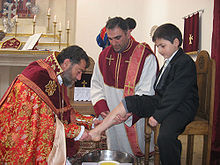
In some denominations of Christianity, there are a number of regulations involving cleanliness before prayer,[1] observing days of ritual purification,[2] as well as those concerning diet and apparel. The Bible has many rituals of purification in areas ranging from the mundane private rituals of personal hygiene and toilet etiquette to the complex public rituals of social etiquette.[3]
Certain Christian rules of purity have implications for bodily hygiene and observing cleanliness,[4] including sexual hygiene,[5] menstruation and toilet etiquette.[6] In the Coptic Orthodox Church, the Ethiopian Orthodox Church and the Eritrean Orthodox Tewahedo Church male circumcision is an established practice.[7] Around the time of Tertullian, an early Church Father, it was customary for Christians to wash their hands (manulavium), face (capitilavium) and feet (pedilavium) before prayer, as well as before receiving Holy Communion.[8] The rite of footwashing employed a basin of water and linen towels, done in the imitation of Christ.[9]
Christianity has always placed a strong emphasis on hygiene,[10] and water plays a role in the Christian rituals.[1] The Church also built public bathing facilities that were separate for both sexes near monasteries and pilgrimage sites; also, the Catholic popes situated baths within church basilicas and monasteries since the Early Middle Ages.[11] Public bathhouse were common in medieval Christendom larger towns and cities such as Constantinople, Rome, Paris, Regensburg and Naples.[12][13]
Many Christian monastic communities throughout history have emphasized cleanliness and hygiene as part of their spiritual practice.[14] Protestant Christianity also played a prominent role in the development of the spas in Northern Europe.[15] A major contribution of the Christian missionaries in Africa,[16] Asia and other places was better health care of the people through hygiene and introducing and distributing the soaps.[17][18]
- ^ a b Z. Wahrman, Miryam (2016). The Hand Book: Surviving in a Germ-Filled World. University Press of New England. pp. 46–48. ISBN 9781611689556.
Water plays a role in other Christian rituals as well. ... In the early days of Christianity, two to three centuries after Christ, the lavabo (Latin for "I wash myself"), a ritual handwashing vessel and bowl, was introduced as part of Church service.
- ^ H. Bulzacchelli, Richard (2006). Judged by the Law of Freedom: A History of the Faith-works Controversy, and a Resolution in the Thought of St. Thomas Aquinas. University Press of America. p. 19. ISBN 9780761835011.
The Ethiopian and Coptic Churches distinguishes between clean and unclean meats, observes days of ritual purification, and keeps a kind of dual Sabbath on both Saturday and Sunday.
- ^ Riches, John (2000). The Bible: A Very Short Introduction. Oxford: Oxford University Press. p. ch. 1. ISBN 978-0192853431.
- ^ Portmann, John (2013). The Ethics of Sex and Alzheimer's. Taylor & Francis. pp. 13–18. ISBN 9781135122126.
- ^ Engler, Stausberg; Michael, Jackson (2016). The Oxford Handbook of the Study of Religion. Oxford: Oxford University Press. pp. 610–615. ISBN 9780198729570.
- ^ E. Clark, Mary (2006). Contemporary Biology: Concepts and Implications. University of Michigan Press. p. 613. ISBN 9780721625973.
Douching is commonly practiced in Catholic countries. The bidet ... is still commonly found in France and other Catholic countries.
- ^ DeMello, Margo (2007). Encyclopedia of Body Adornment. ABC-Clio. p. 66. ISBN 9780313336959.
Coptic Christians, Ethiopian Orthodox, and Eritrean Orthodox churches on the other hand, do observe the ordainment, and circumcise their sons anywhere from the first week of life to the first few years.
- ^ Cite error: The named reference
Ferguson2013was invoked but never defined (see the help page). - ^ Stutzman, Paul Fike (1 January 2011). Recovering the Love Feast: Broadening Our Eucharistic Celebrations. Wipf and Stock Publishers. ISBN 978-1-4982-7317-6.
- ^ Cite error: The named reference
Warshwas invoked but never defined (see the help page). - ^ Cite error: The named reference
Mary Thurlkillwas invoked but never defined (see the help page). - ^ Black, Winston (2019). The Middle Ages: Facts and Fictions. ABC-CLIO. p. 61. ISBN 9781440862328.
Public baths were common in the larger towns and cities of Europe by the twelfth century.
- ^ Kazhdan, Alexander, ed. (1991). Oxford Dictionary of Byzantium. Oxford University Press. p. 2226. ISBN 978-0-19-504652-6.
- ^ Cite error: The named reference
Paolo Squatritiwas invoked but never defined (see the help page). - ^ Cite error: The named reference
ASpiritualHistorywas invoked but never defined (see the help page). - ^ Newell, Stephanie (2006). International Encyclopaedia of Tribal Religion: Christianity and tribal religions. Ohio University Press. p. 40. ISBN 9780821417096.
- ^ Channa, Subhadra (2009). The Forger's Tale: The Search for Odeziaku. Indiana University Press. p. 284. ISBN 9788177550504.
A major contribution of the Christian missionaries was better health care of the people through hygiene. Soap, tooth–powder and brushes came to be used increasingly in urban areas.
- ^ Thomas, John (2015). Evangelising the Nation: Religion and the Formation of Naga Political Identity. Routledge. p. 284. ISBN 9781317413981.
cleanliness and hygiene became an important marker of being identified as a Christian
© MMXXIII Rich X Search. We shall prevail. All rights reserved. Rich X Search
